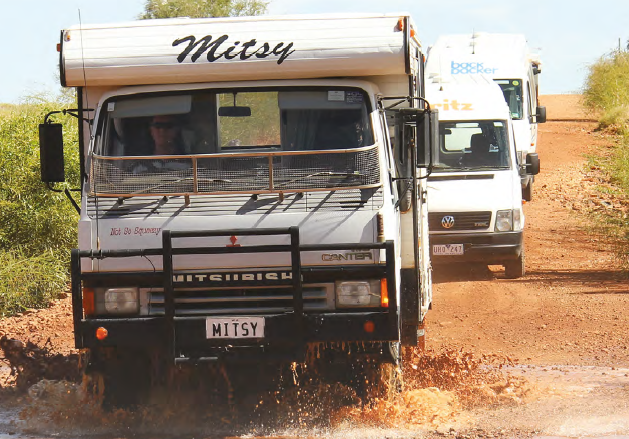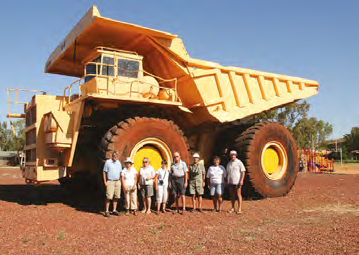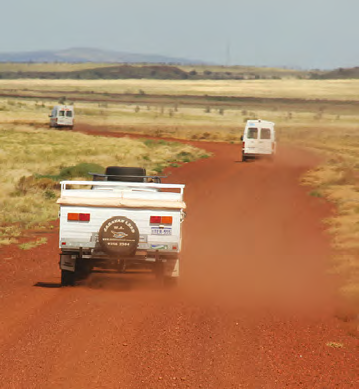
Water crossing on the Millstream-Pannawonica Road, Pilbara, WA
Apart from enjoying all the sights and experiences along the way, one of the best things about travelling around this great country of ours is the sharing of your adventure with others.
Now, clearly, the best opportunity to enjoy the social side of your travels is the daily ritual of happy hour whether you are staying in a caravan park, national park, outback station, or in an overnight rest area. Yes, towards the end of the day, out come the camp chairs, usually a few drinks and nibbles and with those camped nearby we all enjoy an hour or so of sociable chit-chat before tucking ourselves away in bed for the night.
If you take things a little further and like the idea of actually travelling with others, then this arrangement has some quite useful benefits as well: having someone to lend a hand if you experience trouble (mechanical, accident, illness or otherwise); to enjoy the comfortable feeling of safety in numbers; to benefit from the local knowledge of those who have been to some of the places before and, perhaps best of all, you have a built-in happy hour group at the end of each day.
Just be aware that there are some pros and cons to consider before you commit yourself to travelling in company.
Quite understandably there are some travellers who really don’t like any type of restrictions on what they do, where and when to go and to stop, how far they travel in a day, and there is the challenge of getting along with people with differing opinions and interests. There are a number of things to consider. Your willingness to compromise is also important in these situations to gain the benefits that ‘togetherness travelling’ brings with it.
There are three or four main ways you can join with other travellers and again, they all have their for and against in terms of what suits some people, and what won’t necessarily suit others.

At a lookout at Cossack, Pilbara, WA
CLUB OUTINGS
One of the main ways to experience and enjoy group travel out there is with one of the many CMCA chapters or other motoring or caravan clubs throughout the country. Such groups are beaut ways to get away for short or long trips or to specific events and rallies with other like-minded travellers.
To ensure you don’t dive in to this club situation and regret it later most allow you to attend two or three of their events as a visitor before joining – and paying membership fees – enabling you to decide if this form of travel is in fact for you.

Dwarfed by a Haulpack 750 on display at Wickham, WA
TAG-A-LONG TOURS
Another way of travelling in a group is to join a tag-a-long tour, which are usually quite highly organised with a specific destination/s, and with pre-arranged campsites. Sometimes even meals are included and the whole trip is completed within a pre-determined timeframe. These trips are usually under the control of a tour leader who is an experienced traveller to the destination concerned and organises a wide variety of things on behalf of the group along the way. Such groups are a great way of meeting new people; they take away any need to worry about your tour itinerary and are particularly good when travelling to more remote destinations which you would be unlikely to travel to by yourself.

Along the dusty road to Python Pool, Pilbara, WA
TRAVELLING WITH FRIENDS
The other main way of touring in company is to undertake trips with friends or relatives – perhaps travelling with two, three or more rigs. In theory this sounds like a wonderful idea. The reality, however, is that such arrangements can sometimes be quite tricky or, at worst, end up in a real relationship disaster.
Once again, it often comes down to the temperaments of the participants, the need to sometimes compromise, work together on decision making, and try to understand the others’ viewpoint, etc. In fact, you won’t have to delve too deeply to find examples where people who have known and socialised with each other, sometimes over many years, to then almost come to blows when they have found as their trip progressed, they were having many disagreements about a whole range of things.
In the end, if things go really sour, they actually scrap their travelling together arrangement and head off separately. You can sometimes see a different side of people when you have to live/travel with them day in and day out. If you are unsure of how things will go on a long trip with particular people, perhaps try taking a short trip or two (over a weekend) and see how it all works out before committing to a longer journey with them.
Clearly the concept of joint travel is a good one for many people, but to help make it work it is important that before you start (particularly on a long venture) you should sit down and discuss the trip and how all the arrangements will best work for your group.

Breakfast time - Dales Campground, Karijini National Park
Some of the key things that everyone needs to understand and agree on are:
If you decide to travel closely together, here are a few ideas that could help:
… and of course, when travelling in a group there is often the question of how will the group handle the challenge of comfort breaks. If you have your own on-board toilet facilities, no problem, or use public toilets in towns or in rest areas where provided. In the bush, well, it usually is as simple as ‘ladies to the right, gents to the left’ and all potential embarrassments are overcome!
Another travelling option that works well for some people is to simply team up with others from time to time. Perhaps you have clicked with a couple you have met along the road and decide to tag along with each other to the next mutual destination, maybe only a day or two and to arrange a loose ‘meeting up again’ in a week or so further down the track.

At Python Pool, Millstream Chichester NP, Pilbara, WA
In the end, however, always remember this is your holiday and you are out there to enjoy yourself. Think about the options and decide what suits you – perhaps sometimes travelling with a club, with a small group or by yourself, without being locked into any one style. Happy travels.

Lunch stop on the Millstream- Pannawonica Road, Pilbara, WA
Category: Features
Written: Sun 01 Mar 2015
Printed: March, 2015
Published By: